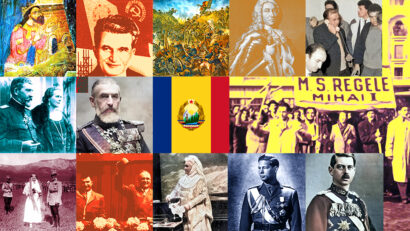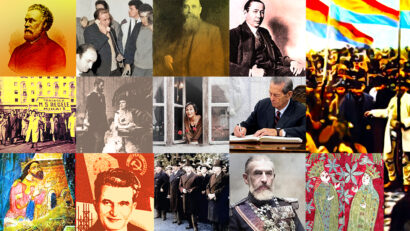Lascar Catargiu
Lascar Catargiu was one of the most important political figures of the 19th century. He was the descendant of a rich noble family of Moldavia, and was born in 1823, a time when the state was modernizing and systematizing. Before 1859, he held various positions in local administration in the Principality of Moldavia. He was a conservative as orientation, he militated for the union of Moldavia with Wallachia, and had an active role in the election of Alexandru Ioan Cuza in both principalities. He was one of the most effective and resolute Romanian politicians. In coalition with liberals, he was also instrumental in removing Cuza in 1866, when his rule endangered the existence of the Romanian state. He was a member of the princely lieutenancy in 1866, and was an active supporter of the idea of installing a constitutional monarchy from a foreign dynasty. A conciliatory spirit, and a very hard worker, Lascar Catargiu emerged as the leader of the Conservatives, who saw in him a balancing agent within the party.
Lascar Catargiu was a providential figure in the history of Romania in the second half of the 19th century. In 1871 he saved Romania from instability, as told to us by historian Sorin Cristescu:
“His role was totally special, at a certain point he saved the rule of Prince Carol I. A dramatic moment occurred on the night of March 10, 1871, when he was faced with a difficult situation. Its impossible to know if Carol was truly determined to abdicate, but he intervened forcefully while a protest was being held in Bucharest by the Liberals, who were attempting to compromise the German colony in Bucharest, along with the ruler of the country. He went to the king in his quality of princely lieutenant, and told him he would offer him a strong government if he is appointed Prime Minister.”
What made Catargiu such a strong leader of the conservatives in a party full of personalities? Sorin Cristescu answers:
“He had accrued very high prestige when it comes to Carol, because he was the first president of the Council of Ministers appointed by Carol, on May 11, 1866. He went on to govern until July 13, 1866. How did this man come to rule the Conservatives? If we think of how the Conservatives were, we see that they were a party of personalities. It was a party of highly educated people, the best known being Petre P. Carp and Titu Maiorescu. We see Lascar Catargiu as a man without oratory pretense, without intellectual pretense, who was not a sharp tongued conversationalist. He was a spiritually modest, but everyone felt at ease around him, while in a discussion with Petre Carp you might be made to feel inferior. Carp was always eager to assert his superiority towards other party members. This made Lascar Catargiu very well liked, and always preferred. His spiritual modesty made everyone want him as a party chairman, because he never insulted anyone.”
Lascar Catargiu was prime minister of Romania four times. The government he headed between 1871 and 1876 led Romania to the independence it gained during the Russian-Turkish war of 1877-1878. Ironically, Catargiu was not to be able to boast the victory, whose laurels went to his successor, the equally famous politician Ion C. Bratianu. Here with details about the significance of the first Catargiu government is historian Sorin Cristescu:
“This government was the first after the union of the Principalities which saw its four-year term through to the end. It was so effective that it won the elections with no problems. It also made a gesture of independence by defying the order of the Ottoman sultan which forbade Romania signing any trade treaties with other states. He signed the trade convention with Austria in 1875, showing Romanias independence. He would have led 4 more years if it werent for the Christian revolt in Bosnia Herzegovina of August 1875. Within a few months, everyone understood that there was going to be a war between the Ottomans and the Russians, and that Romania would have to join in the war.”
One of the best known sayings of the era is: Majesty, that cant be done. It was uttered by Lascar Catargiu, and showed his firmness, courage, and inflexibility when his limits were tested, even if by the queen. Here is Sorin Cristescu with details:
“At that time, when he made that statement, he was Minister of the Interior in the government headed by another conservative, General Ioan Emanoil Florescu. He said this as an obvious point. What the queen was trying to do was inadmissible, to marry Crown Prince Ferdinand with her lady in waiting, Elena Vacarescu. He best expressed the attitude of an elite that suddenly coalesced around a proposal.”
In 1899, at 76 years of age, Lascar Catargiu died of a heart attack, on the very day that Carol I was appointing him prime minister for the fourth time. In the obituary he wrote for him, historian and philosopher Titu Maiorescu said about him that he was “honest, and tireless in the minutiae of administration. The authority he enjoyed within the Conservative Party is owed to these qualities and his courage.”

Steliu Lambru, 25.02.2020, 18:39
Lascar Catargiu was one of the most important political figures of the 19th century. He was the descendant of a rich noble family of Moldavia, and was born in 1823, a time when the state was modernizing and systematizing. Before 1859, he held various positions in local administration in the Principality of Moldavia. He was a conservative as orientation, he militated for the union of Moldavia with Wallachia, and had an active role in the election of Alexandru Ioan Cuza in both principalities. He was one of the most effective and resolute Romanian politicians. In coalition with liberals, he was also instrumental in removing Cuza in 1866, when his rule endangered the existence of the Romanian state. He was a member of the princely lieutenancy in 1866, and was an active supporter of the idea of installing a constitutional monarchy from a foreign dynasty. A conciliatory spirit, and a very hard worker, Lascar Catargiu emerged as the leader of the Conservatives, who saw in him a balancing agent within the party.
Lascar Catargiu was a providential figure in the history of Romania in the second half of the 19th century. In 1871 he saved Romania from instability, as told to us by historian Sorin Cristescu:
“His role was totally special, at a certain point he saved the rule of Prince Carol I. A dramatic moment occurred on the night of March 10, 1871, when he was faced with a difficult situation. Its impossible to know if Carol was truly determined to abdicate, but he intervened forcefully while a protest was being held in Bucharest by the Liberals, who were attempting to compromise the German colony in Bucharest, along with the ruler of the country. He went to the king in his quality of princely lieutenant, and told him he would offer him a strong government if he is appointed Prime Minister.”
What made Catargiu such a strong leader of the conservatives in a party full of personalities? Sorin Cristescu answers:
“He had accrued very high prestige when it comes to Carol, because he was the first president of the Council of Ministers appointed by Carol, on May 11, 1866. He went on to govern until July 13, 1866. How did this man come to rule the Conservatives? If we think of how the Conservatives were, we see that they were a party of personalities. It was a party of highly educated people, the best known being Petre P. Carp and Titu Maiorescu. We see Lascar Catargiu as a man without oratory pretense, without intellectual pretense, who was not a sharp tongued conversationalist. He was a spiritually modest, but everyone felt at ease around him, while in a discussion with Petre Carp you might be made to feel inferior. Carp was always eager to assert his superiority towards other party members. This made Lascar Catargiu very well liked, and always preferred. His spiritual modesty made everyone want him as a party chairman, because he never insulted anyone.”
Lascar Catargiu was prime minister of Romania four times. The government he headed between 1871 and 1876 led Romania to the independence it gained during the Russian-Turkish war of 1877-1878. Ironically, Catargiu was not to be able to boast the victory, whose laurels went to his successor, the equally famous politician Ion C. Bratianu. Here with details about the significance of the first Catargiu government is historian Sorin Cristescu:
“This government was the first after the union of the Principalities which saw its four-year term through to the end. It was so effective that it won the elections with no problems. It also made a gesture of independence by defying the order of the Ottoman sultan which forbade Romania signing any trade treaties with other states. He signed the trade convention with Austria in 1875, showing Romanias independence. He would have led 4 more years if it werent for the Christian revolt in Bosnia Herzegovina of August 1875. Within a few months, everyone understood that there was going to be a war between the Ottomans and the Russians, and that Romania would have to join in the war.”
One of the best known sayings of the era is: Majesty, that cant be done. It was uttered by Lascar Catargiu, and showed his firmness, courage, and inflexibility when his limits were tested, even if by the queen. Here is Sorin Cristescu with details:
“At that time, when he made that statement, he was Minister of the Interior in the government headed by another conservative, General Ioan Emanoil Florescu. He said this as an obvious point. What the queen was trying to do was inadmissible, to marry Crown Prince Ferdinand with her lady in waiting, Elena Vacarescu. He best expressed the attitude of an elite that suddenly coalesced around a proposal.”
In 1899, at 76 years of age, Lascar Catargiu died of a heart attack, on the very day that Carol I was appointing him prime minister for the fourth time. In the obituary he wrote for him, historian and philosopher Titu Maiorescu said about him that he was “honest, and tireless in the minutiae of administration. The authority he enjoyed within the Conservative Party is owed to these qualities and his courage.”





























